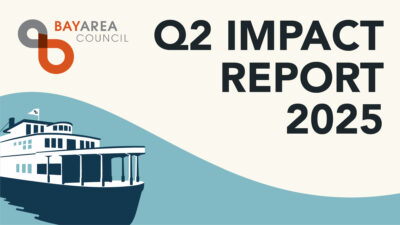California Resilience Challenge Spotlight: Keeping the Groundwater at Bay
This is one in a series of profiles of the 12 winners of the California Resilience Challenge, a first-of-its-kind statewide initiative of the Bay Area Council and a diverse array of partners. The Challenge recently awarded $2 million in planning grants for a variety of innovative projects in communities across the state to address the growing impacts of climate change, including drought, floods, wildfires, and sea-level rise.
The Bay Area’s response to rising sea levels is critical given its unique location and geography. Emergent groundwater flooding is expected to impact numerous low-lying coastal Bay Area communities, which is home to over 7 million people and contains vital infrastructure. Despite this threat, the region’s current climate adaptation plans neglect this hazard. Emergent groundwater often occurs before coastal floodwaters surpass the shoreline, thus producing flooding without toppling existing flood control structures. This type of flooding poses a host of threats, including damage to buried infrastructure, flooding in underground structures such as BART stations and tunnels, and the release of contaminants that have long been trapped under cement caps.
The Bay Area is not an outlier in its underestimation of the threat of emergent groundwater.
Nationwide, climate adaptation plans fail to prepare for the possibility of flooding from below. Thankfully, the Aquatic Science Center, in partnership with Silvestrum Climate Associates and UC Berkeley, developed a comprehensive project designed to address this critical data gap needed to respond to rising groundwater levels.
With a grant from the California Resilience Challenge, the center is studying the linkages between sea-level rise, groundwater elevation, and precipitation. Specifically, the project aims to develop groundwater maps that consider eight sea-level rise scenarios ranging from 12” to 108” for four Bay Area counties. Collectively, the study will help regional infrastructure managers identify at-risk communities and address potential groundwater vulnerabilities, which would otherwise go ignored.
The data will enhance the climate adaptation strategies of the project’s city and county partners, including Marin County, San Mateo County, the City and County of San Francisco, and Alameda County, which contains the City of Alameda, Albany, Berkeley, and Emeryville. The project is crucial for individuals who reside in disadvantaged communities as they are predicted to be among the first to suffer adverse outcomes due to emergent groundwater. Local at-risk communities include East Oakland, Marin City, and Bayview/ Hunters Point, where residents are predominantly low-income people of color.
While this initiative is designed to further protect the San Francisco Bay shoreline from sea level rise, the methodology and analysis provided by this project can be replicated across California. Therefore, this initiative has the potential to facilitate the development of a more comprehensive climate adaptation plan state-wide.
Special thanks to California Resilience Challenge funders PG&E, JPMorgan Chase & Co., Valley Water, Metropolitan Water District, Southern California Edison, Resources Legacy Fund, Alaska Airlines, SFPUC, SD Bechtel Jr. Foundation, and Pillsbury; and special thanks to Advisory Committee members AECOM, Pillsbury, Climate Resolve, Environmental Defense Fund, Ceres, and the Governor’s Office of Planning and Research.
To learn more about the California Resilience Challenge, please contact Policy Associate Anna Sciaruto.





